The Best Gets Better
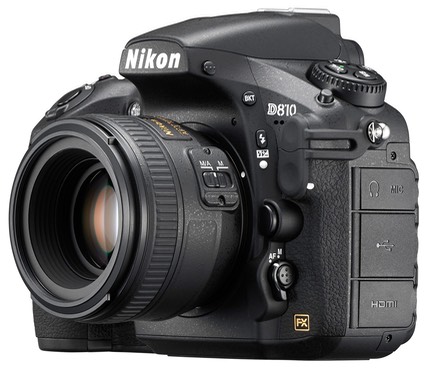
What is It?
The D810 announcement in mid-2014 was a bit of a surprise. Why? Because previous to the D810, Nikon hadn’t really ever done a true incremental update on a small FX body. The D700 never got an incremental update, for example. The D800/D800E combo was not quite an update to the D700, either, as the character of the camera changed completely from a low light speed shooter to a brighter light studio megapixel wiz. The D610 “update” was a sham to try to avoid the shutter dust issue head on.
More interestingly, Nikon didn’t have to update the D800/D800E. These cameras were what I wrote as being the best well-rounded DSLR on the market in 2012 and they still were in 2014 when the D810 was announced. Indeed, the D800/D800E really didn’t have any direct competition. The closest competition was the Canon 5DIII at 21mp and the Sony A7r mirrorless camera with essentially the same sensor as the Nikon bodies. But frankly, neither really directly compete with the D800/D800E, and now the D810.
This will be a bit of an abbreviated review, as I don’t intend to repeat all the things I wrote in my D800/D800E review. I strongly encourage you to go back and re-read the What is It? and How’s it Handle? sections of that review before proceeding. I’m going to assume that you have and that things that haven’t changed don’t need discussion.
So what did change?
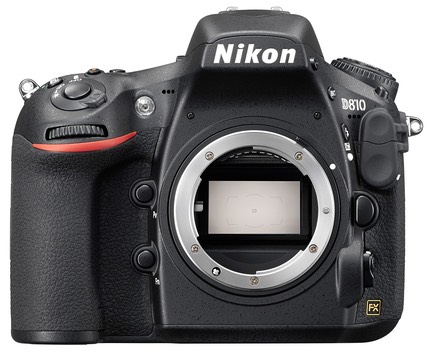
Let’s start with the sensor. While the basic sensor itself hasn’t changed that I can tell, the filtration sitting on top has. In particular, the D810 is different than a D800E: the D800E has a AA filter that first filters information on one axis, then replaces it; the D810 does no such thing. The data is never resolution filtered at all. It’s a very subtle thing, but I think I detect an eensy bit more integrity to low-level detail in the D810 over the D800E. But it’s nothing that anyone should use as a justification to buy the camera. There is no AA-filtered version (e.g. D800) of the camera any more; it’s AA-less as the only option now.
The sensor itself is rated at ISO 64 base, with ISO values out to 12800 (extended to 32 and 51200 via LO and HI settings). I doubt this is a sensor change. This seems to be a slight re-tuning of digital gains, coupled perhaps with some slight filtration changes.
It appears that the Bayer filtration has changed slightly on the D810, as I’m having to change my converter adjustments to keep colors where I like them. This isn’t a big change, but it appears that we’ve lost a tiny bit of color discrimination in the process.
Backing up the slight sensor changes is a real change: EXPEED4. This system-on-chip has a lot of tweaking in it, much of it subtle, but all of it steps forward. Moire suppression has been enhanced for JPEGs, for instance, and there’s the infamous 9mp sRaw capability that’s been added. I say infamous because quite a bit of Internet salivation occurred over what is essentially a highly cooked file that’s not nearly as flexible as a real NEF. sRaw files have white balance information, downsizing, and linear curves applied them, all while getting the bit depth down to about 11 (from the D810’s practical maximum of 14). As one of my friends tends to say, it’s like getting 11-bit JPEGs that you can make some faux raw adjustments to.
That’s not to say that sRaw isn’t useful to some, but rather that it’s highly oversold in its capabilities. Shooting sRaw gobbles up a lot of the buffer, but doesn’t give you much in the way of size savings over the smallest 36mp NEF file (12-bit Compressed NEF). My recommendation is just shoot 12-bit Compressed. sRaw doesn’t net you nearly as much gain as you think when all is said and done. Indeed, maybe even no gain. It doesn’t save you time in conversion, it doesn’t convert as easily in some lighting conditions due to the precooked choices, and it doesn’t really save you file space on your hard drives. Plus it eats up valuable buffer space.
Another aspect of EXPEED4 is its role in autofocus. The D810 gets the Group Autofocus mode introduced with the D4s, and I’m pretty sure that the new EXPEED is doing some of the heavy lifting here. Ditto with the new ability to recognize faces while focusing in some modes.
Frame rate increased to 5 fps in FX (up from 4), 6 fps in 1.2x and DX crop, and 7 fps in DX crop when using the MB-D12. Of all the changes in the camera, this is the one that I kept noticing while shooting with my D810 in Africa this past summer. Even the small bump in speeds makes the D810 more of an action camera than its predecessors. Coupled with the fairly large buffer, I never felt constrained by the camera in terms of capturing action. Indeed, I often left the camera in 1.2x crop as we tried to approach animals, giving myself a bit more “reach”, saving file space, and getting a faster camera all with one small change. While that’s not dramatically different than with my D800E, it’s noticeably different.
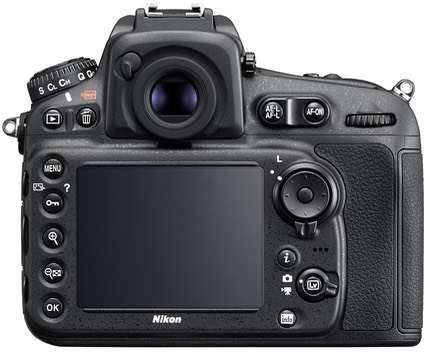
On the back the 3.2” LCD went from 921k dots to 1.3m. I doubt that this is the change that’s made Live View magnification better, but every little bit helps. And, yes, Live View magnification is cleaner with the D810 than with the D800/D800E. How Nikon achieved that is unexplained by Nikon marketing; indeed, that it changed at all isn’t mentioned by Nikon marketing.
In fact, while you might think I’m bashing Nikon again, as it turns out that’s a relevant comment to this review: I found quite a few things about the D810 that had changed for the better, but which Nikon didn’t really mention, let alone explain, in their marketing materials.
Take the shutter, for example. The D800 has a lot “snap” sound to it. The D810 has a quieter and less obnoxious “clunk” sound to it. The D800 shutter is higher pitched, too, which some will find problematic in quiet spaces. The shutter doesn’t actually measure as significantly quieter, but it’s far less objectionable in sound, which amounts to the same thing when you’re shooting quiet indoor events. The shutter also has the ability to use electronic first curtain in some typically tripod scenarios, which minimizes shutter shock, a nice touch. But Nikon fails to describe the nuances of how and when that works.
On the video side, 1080P is now supported at 50 and 60 fps. One oddity: the D750 has a new MOVIE SHOOTING menu (tab), the D810 doesn’t. We’ve got the room for the tab, and moving the video stuff off the SHOOTING menu definitely helps a bit with the menu scrolling we’re getting these days on Nikon DSLRs. It also allows you to configure the camera to switch between still and video shooting without having to menu dip (e.g. different ISO settings are supported on the D750). Let’s hope that Nikon quickly consolidates the changes they made to the D750 menus to the D810.
Speaking of video, Nikon made two very nice changes: zebra stripes are now available while shooting, and you no longer have to take the card out to record uncompressed HDMI. Indeed, you can record uncompressed HDMI via the external connector and compressed MPEG onto your memory card simultaneously, exactly what we all wanted in the first place.
We have a new Picture Control (Flat), along with a new slider for all the Picture Controls (Clarity). The first was mostly aimed at video shooters, while the second gives JPEG shooters another thing to tweak. I should note again that the color response has changed a tiny bit when using the same Picture Control as with the D800/D800E. Nikon appears to have to tried to engineer the same result from Picture Controls, but didn’t quite nail it with the D810: it’s a wee bit different in Standard, for example.
Button additions/changes/shifting has been kept to a minimum, but there is one that bothers me, and that’s moving the metering from a dial around the AE-L/AF-L button to where the bracket button is on the top left button cluster. The bracket button then moves the side of the flash housing. The reason for this switch of the switch has to do with the fact that metering has a new option: highlight preservation. Why that couldn’t have been done by adding a fourth position to the old switch escapes me. Highlight preservation is a special spot metering mode, by the way. I’ll have more to say about that in a bit.
In the realm of “small” changes, the illuminated information in the viewfinder is now a white OLED, not pale yellow. There’s a primitive split-screen zoom display that Nikon claims is great for leveling horizons. And the camera can shoot beyond 100 frames at a time.
Some odd bits abound. For instance, with no lens on either camera and both in Manual exposure mode, my D800’s tell me I’m at f/2.8 (incorrect) while my D810 tells me I’m at delta 0 (correct). Obviously, Nikon has found and cleaned up some bugs and idiosyncrasies.
On the other hand, it appears that they’ve added new ones. HDMI output in still Live View, for example, has a new twist to it (shared with the D750): it defaults to 480P. According to the manual, you’re not supposed to be able to set Screen Display Off and Dual Monitor Off in the Advanced section. You can. And then the HDMI fails. Oh, and help for these menu items? You guessed it, the help button gives no help in deciphering these new options.
Finally, the body lost a half ounce (20g), the right hand grip position has been completely re-tuned on both the front and rear of the body, and we now have three separate connector doors on the left side of the body instead one big flap.
For an incremental release, Nikon spent a lot of time refining elements of the original D800.
How’s it Handle?
Based upon the press release and specs, I wasn’t expecting the D810 to feel like a different camera than the D800E I used as my primary camera before. Boy do all those little things add up, because the D810 feels more natural in my hand and more responsive in most ways than my D800E. No big changes here, just lots of small things tweaked that makes the experience a little more likable. And it was already quite likable.
But let’s get my nit out of the way first: you guessed it: buttons moving. Now I’ll be the first one to admit that this impacts me more than most of you: because of this site, I’m updating cameras on every iteration. But Nikon is moving my cheese on every iteration. Basically I get dialed into a body and then, boom, along comes another body that replaces it and I need to spend some time getting back to full rapport.
I’m still trying to figure out why we have to have two Info buttons now (one labeled i, the other info). On the D810 pressing i now is the equivalent to pressing info twice on the D800. We needed a new button for that why? And of course pressing the info button twice on the D810 doesn’t do what the D800 did, so you have to adjust to the new button. Worse still, the D750 buttons don’t quite do the same thing as the D810 ones. Make up your mind Nikon, and stick to it. Oh, and it wasn’t broken before you started fixing it.
I’ve already mentioned the migration of the metering and bracket buttons. I guess the good news is that I use neither of them much, and I use the metering button more than the bracket button, so it’s a logical candidate for the button farm on the top left of the camera. Still, I have to think about whether I’ve got my D800E or my D810 in my hand when I’m thinking about changing metering with my eye at the viewfinder, and I don’t want to have to think. "Do, think not" is what my internal Yoda is telling me.
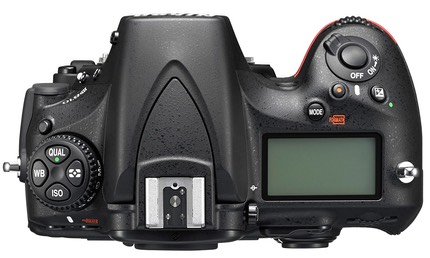
The new right hand position is better, but not so much for the reason that everyone seems to write about: “deeper finger grip.” First, that’s not quite right. It’s not the depth of the grip that’s changed, it’s the amount of “bulge” your fingers have to wrap around that’s changed. I would describe the front part as thinner, not deeper.
For me it’s the more prominent thumb ridge on the back that’s made the biggest difference. I’m really gripping into two helpers now (front finger bulge, rear thumb ridge), whereas before I had to pull my hand further around and hold it a little tighter on the back to get the opposition necessary to “grip” the camera. It’s a subtle thing, but it’s definitely better than before.
Even after months of shooting, I’m unsure about the change to white info in the viewfinder. It’s definitely “crisp” looking and clear. It’s also a bit bright. Some will find that better, as it distracts them down to the info. It’s a bit like a speedometer that’s obvious versus one that is tucked away and subtle on a car. Some will like it, some won’t. I’m agnostic at the moment.
The D800 firmware was updated to allow ISO assignment via the Record Video button, and that comes with the D810, as well, thankfully.
One final thing: the prism (and I think focus screen) were changed a bit by Nikon. They do claim that the new prism is coated differently and should let through more light. I’m not sure how much I should trust my aging eyes on this one, but yes, I do think that viewfinder is a teeny bit clearer in low light. Not as much a difference as between the Df and D610—which was a small difference, too—but enough to be noticed by some.
Overall, the D800/D800E handled quite well, and the D810 doesn’t mess anything up (once you get used to the small button migration).
Performance
Battery: better. Not substantively better, but better. I haven’t found a situation where I’ve needed more than one battery a day. Indeed, in Africa I was charging my D810 batteries about once every three days, despite using the camera from dawn to dusk with VR lenses and doing a fair amount of Live View work. Still not D3/D4 levels of battery performance, but better than virtually everything else I’ve used other than a Canon 1Dx.
Focus: better. Not substantively better, but better (sensing a pattern yet? ;~). I found myself dialed in very quickly with the new autofocus system, though I’m still experimenting with when Group might be better than 9-Point. The difference is that the camera has a little more leeway to make its choice instantly with Group, whereas with 9-point it’s always going to try your choice first. Also note that Group has a bit of Closest Subject Priority built back into it, something that was removed from the autofocus system in modern DSLRs. I like that, as it’s predictable, whereas the more paternalistic AF decision making of Dynamic AF is much less predictable.
The thing that impressed me most wasn’t that the D810’s focus system was faster than my D800E’s, but that it just isn’t having any real problems with motion despite the fact I can crank the camera up to 7 fps (DX mode with MB-D12). I also noticed that the new 80-400mm was even less prone to hunt on my D810 than my D7100, and the new 80-400mm isn’t prone to hunt in the first place.
The way I’d characterize the D810’s focus system is this: as good as it gets on a Nikon (at least in cameras introduced prior to the D810; the D750 beats it a bit in very low light).
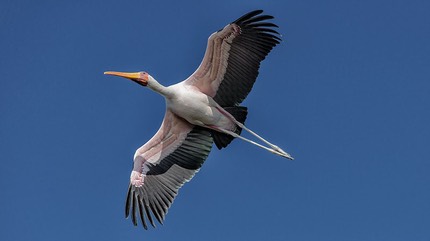
This bird got off center on me (I’ve mostly re-centered it here) yet the system still kept focus. BIF capable? Yes.
Highlight metering: I just used the word paternalistic, and here it is again. The old Olympus highlight metering system that we all loved was a known offset from middle gray. By that, I mean that if you metered on a highlight, the camera put the exposure a fixed distance off from what it would if you metered a gray tone. Nikon’s new highlight metering doesn’t quite work that way. It has this habit of ignoring some highlights. I can see where they came from with that: it’s unlikely that a photographer would want to meter on some small specular highlights, but they might want to meter on a bright area and have the camera adjust.
Where Nikon’s system seems to work well is in the theater. If I meter on faces or costumes made a bit bright by stage lighting, the camera does a pretty good job of picking an appropriate compensation. But that’s my problem with this system: the camera is picking. It does not seem to be absolutely fixed, and as I noted, small brighter highlights will generally be ignored. So if you’re thinking that this is a system for setting perfect ETTR exposures, it isn’t. I’m still testing this aspect of the camera, so perhaps I’ll have an Aha! moment and figure out the algorithm Nikon is using. I wish they would just tell us, though.
Dynamic Range: same. Measures the same, looks the same in my testing.
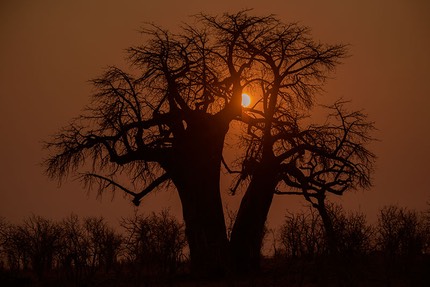
What, you think there’s no detail in this shot? Same shot, different processing:

As usual, the D810 simply has a lot of ability to pull up considerably underexposed shadow detail. It’s not a limitless capability, but it’s incredibly large and useful.
Resolution: same, though I think I detect an extremely slight improvement in integrity of acuity on completely random small detail. I don’t know how to test reliably for a change this small, though. It’s something I sense, but can’t quite put my finger on. It’s also not clear whether this is just improvement from shutter slap removal or the change to the way the data isn’t anti-aliased.

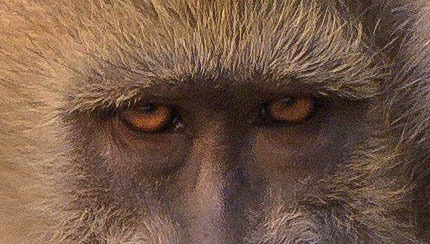
Sharp, even at ISO 800.
Noise: JPEGs? Better. NEFs? Can’t really find any difference worth reporting, though note what I said about a small color change above. The D810 renders slightly different than the D800/D800E. Many people won’t notice, but it’s there, and it’s especially true in certain types of lighting, which makes me suspect slight changes to R and B filtration.
I will say this about image quality: if you’re a JPEG shooter, Nikon’s made enough changes that the D810 seems like a different and better camera than the D800/D800E. The tuning between edge acuity in sharpening and noise reduction in areas, in particular, seems really much better dialed in than before. I think most D800/D800E shooters would probably find that they can push the ISO a little further than they used to because of this.
Final Words
The D810 is the most well-rounded DSLR you can buy right now. Indeed, the changes have improved that statement from the one I made about the D800/D800E. You can push JPEGs a little higher in ISO, your raws should benefit from the shutter changes if you’re deep into maximum shot discipline, the focus seems a little more sure and a bit snappier, and that 1 fps change in speed does actually push the D810 into the action camera realm just enough that I don’t feel silly shooting it against all those 10 fps beasts others are using. The Live View magnification has improved to where it is mostly usable, the shutter is quieter, the grip is grippier.
What more would you want short of something entirely radically new?
Funny thing is, all these small changes really add up into the camera feeling completely new and refreshed, and yes, better. I’m not alone in this opinion. Every pro I’ve talked to who’s had a D800 model and moved to the D810 says the same: "better camera, but I’m not entirely sure why.” Subtle changes do make a difference, it seems. Moreover, Nikon really didn’t take any steps backwards while they were doing all this tuning, so the tuning really does show off.
I can therefore heartily recommend the D810 to most shooters. It’s an excellent camera, nay, a superb camera.
But…
Oh no, Thom, you have a “but"? Yes I do. The D800/D800E are still being sold in some places, and I’m seeing a lot of refurbished ones hitting the market for about US$1000 less than a new D810 (NikonUSA sells a refurbished D800 for US$2200 at the moment). That’s enough of a price differential that it should make you hesitate a bit. But only a bit. You really have to consider if you can use that extra money usefully (e.g. get a new prime lens for your camera, such as the very nice 20mm f/1.8) versus finding something about the new model is so enticing that money is no object. Plus remember that the warranty on refurbished is only 90 days.
I actually don’t expect that choice to last long. The D800 and D800E have always been reasonably popular cameras, and they didn’t last all that long on dealer shelves, so there isn’t a lot of extra inventory sitting around.
On the other hand, there’s also the D750 to consider. The two things you really give up with a D750 over the D810 are build quality (plus consumer style controls) and 12mp. But the D750 comes at quite a discount from the D810. Frankly, the change in build quality isn’t worth the extra money on its own, so you really have to need the extra pixels to even begin to cover the price spread between the two.
For most people, the D750 is the best DSLR. That said, I still believe that the D810 is the best DSLR you can buy. Those are not contradictory statements, they’re statements where price is considered in one, price is no object in the other. So, are you price sensitive? The D750 is your answer. Not price sensitive? The D810 should be on your radar.
Highly Recommended (2014, 2015, 2016)
Support this site by purchasing from this advertiser:
